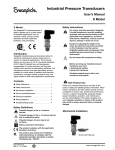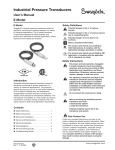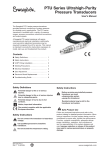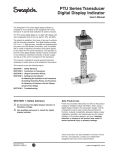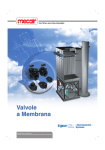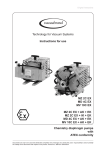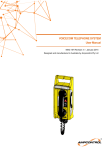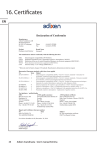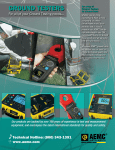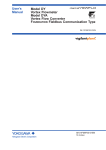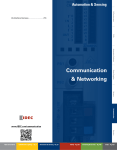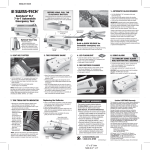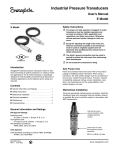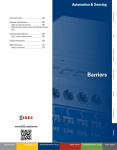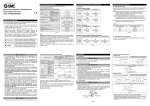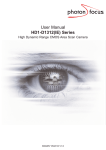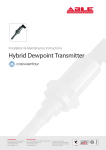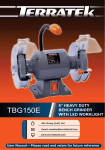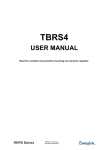Download Industrial Pressure Transducers, User Manual, T Model (MS
Transcript
Industrial Pressure Transducers User’s Manual T Model T Model Safety Instructions For proper and safe operation, Swagelok T model transducers must be installed, operated, and serviced according to NEC, applicable local regulations, and these instructions. Otherwise, serious personal injuries, damage or both can occur. The Swagelok® T model transducer is engineered for use in industrial pressure measurement applications where intrinsically safe ratings are required, such as hazardous environments or media, including gases, vapors, or dust. Except for adjusting the length of the wires, the electrical connection provided on the transducer must be used as originally supplied and not bypassed. Only qualified persons should work on theses instruments. Introduction Swagelok industrial pressure transducers allow for electronic monitoring of system pressures in a variety of industrial applications. The products feature an accuracy of 0.5 % Limit point calibration (0.25 % Best fit straight line), temperature compensation to ensure accuracy and long term stability when exposed to temperature variations. The transducers are zero and span adjustable, and are available in a wide variety of process and electrical connections, pressure ratings and pressure units to fulfill many application requirements. Do not exceed the overpressure rating. Before servicing any installed pressure transducer you must ● depressurize system ● purge the transducer Residual material may be left in the transducer and system. Contents Models with Mounted Cooling Element, ensure there is proper air circulation around the cooling element and the element is protected from dust. ■ Safety Instructions . . . . . . . . . . . . . . . . . . . . 1 ■ Mechanical Installation . . . . . . . . . . . . . . . . . . 2 ■ Service and Maintenance . . . . . . . . . . . . . . 2 Models with Mounted Cooling Element, do not touch the cooling element while the transducer is in operation. ■ Electrical Installation . . . . . . . . . . . . . . . . . . 2 ■ Wiring Diagrams . . . . . . . . . . . . . . . . . . . . . . 3 ■ FM and CSA Approval . . . . . . . . . . . . . . . . 3 ■ Intrinsic Safety . . . . . . . . . . . . . . . . . . . . . . . 4 ■ Control Drawing . . . . . . . . . . . . . . . . . . . . . . 4 ■ Troubleshooting Guide . . . . . . . . . . . . . . . . . 5 Safety Definitions Warning Models with Mounted Cooling Element, the surface temperature of the cooling element and the transducer must not exceed the maximum ambient temperature of the application's intrinsically safe rating. Potential danger to life or of serious injuries. otential danger to life or of serious injuries P due to catapulting parts. otential danger of burns due to hot P surfaces. Notice, important information. he product was tested and certified by CSA T International. It complies with the applicable Canadian standards on safety. Certificate-No.: 2199503 The product was tested and certified by FM Approvals. It complies with the applicable U.S.A. standards on safety. MS-CRD-PTI-T R1 04-10-WEL Safe Product Use Follow any enclosed instructions and refer to the product catalog for detailed product information. When using a transducer, the total system design must be considered to ensure safe, trouble-free performance. Function, material compatibility, adequate ratings, proper installation, operation, and maintenance are the responsibilities of the system designer and user. Improper selection or misuse of the product may result in serious personal injury or property damage. www.swagelok.com Electrical Installation Mechanical Installation Do not exceed the max. permissible power supply DC 30 V. The shield / ground connection must be wired to ground at one end to protect the instrument from electromagnetic disturbances. For devices with flying leads, the screen is connected to the housing. The simultaneous connection of the housing and cable screen to ground is only permitted if ground loop problems between the shield connection (e.g. at the power supply) and housing can be excluded. 50 N·m (36 ft·lb) max. Service and Maintenance Zero and Span Adjustment Do not twist or remove housing nut without first removing the fastening screw and electrical connector. Damage to the connector wiring may result. 1. Open the pressure transducer by removing the fastening screw. See Fig. A 2. Adjust the zero point (Z) with the transducer in the pressureless state. See Fig. B and Fig. D. 3.Adjust the span (S) while using a pressure standard with adequate accuracy. See Fig. B and Fig. D.. 4.Check the output signal for each transducer adjustment. Repeat steps 1 through 3 as necessary. 5. Reassemble transducer as shown in Fig. A. • Attach wiring to the appropriate terminals, Fig. C and Fig. D, as shown in diagrams on page 3. Wiring information is also printed on the instrument label. • Be certain that the voltage supply is higher than the minimum required voltage as determined by the maximum load equations. • Refer to the installation conditions shown in the IS Apparatus Control Drawings on page 4. Maximum Load Equations Milliampere output signal, 2 wire Output 4 to 20 mA Supply V (dc) = 10 ➀ to 30 V Max. Load RL (Ω) = (V [dc] – 10 V➀) 0.02 A (Length of flying lead × 0.14 Ω) Terminals See drawings ➀ 11 V for field-case version. Fig. A Fastening screw Fig. C Fig. B Electrical connector Sealing gasket Housing nut Electrical terminals O-ring S = span adjustment Z = zero point adjustment Process connector S = span adjustment Do not attempt to clear the pressure port with a screwdriver or other sharp objects as this may damage the sensing element of the transducer. 2 Fig. D Z = zero point adjustment MS-CRD-PTI-T R1 04-10-WEL Wiring Diagrams Legend Special Instructions for Wiring Power Supply ■ Do not use the MIL-plug for mining applications due to the light metal material. ■ Always connect the housing to earth ground to protect the instrument against electromagnetic fields and electrostatic charges. (+) V dc+ Plus power supply (–) 0 V dc Minus power supply (common, ground) Load (+) S+ (–) S– Minus output signal (common, ground) Plus output signal 2-Wire Systems DIN EN175301-803 L-plug (+) V dc+/S+ (-) Bendix, 6-pin, MIL plug (+) 3 2 (-) (+) (+) 0 V dc/S– M 12 × 1, 4 pin Circular connector (-) E D C (-) (-) (+) 0 V dc/S– Direct wire, flying lead V dc+/S+ (+) (+) V dc+/S+ (+) F A B (-) 1 Bendix, 4-pin, MIL plug V dc+/S+ A D B C 0 V dc /S– Field Case V dc+/S+ (+) V dc+/S+ brown (-) 4 3 1 2 (-) (-) (-) grey = shield (-) 1 2 3 4 5 (-) ➀ green (+) 0 V dc/S– (+) 0 V dc/S– (+) 0 V dc/S– Test – Test + ➀T he transducer current can be monitored during normal operations by connecting an ammeter across the test terminals. For applications in hazardous locations, the internal resistance of the ammeter must be < 15 Ω. Note: Refer to the IS Apparatus Control Drawing on page 4 for additional safe installation information. FM and CSA Approval ■ CSA (Canada and U.S.A.) and FM intrinsically safe: ■Class, I Division 1, Groups A, B, C, and D ■Class II, Division 1, Groups E, F, and G ■Class III Division 1 ■Class I, Zone 0, Group IIC AExia IP65 ■Entity parameters: Vmax = 30 V (dc) Imax = 100 mA at Tamb ≤ 85°C Imax = 87 mA at Tamb > 85°C Pi = 1 W Ci = 22 nF Li = 0 mH MS-CRD-PTI-T R1 04-10-WEL ■ CSA (Canada and U.S.A.) and FM nonincendive: ■Class I, Division 2, Groups A, B, C, and D ■Class II, Division 2, Groups F and G ■Class III, Division 2 ■Field wiring parameters: Vmax = 30 V (dc) Imax = 100 mA at Tamb ≤ 85°C Imax = 87 mA at Tamb > 85°C Pi = 1 W Ci = 22 nF Li = 0 mH ■ Temperature class: ■T6 at maximum ambient 140°F (60°C) ■T5 at maximum ambient 176°F (80°C) ■T4 at maximum ambient 221°F (105°C) 3 Intrinsic Safety Special Instructions for Intrinsic Safety ■ Intrinsically-safe transducers require the use of an approved barrier and an approved power supply to provide full protection in hazardous areas. ■ The internal diaphragm of the transducer must be protected from abrasive substances and pressure peaks, and must not be touched by tools. A damaged diaphragm voids the intrinsic safety performance of the transducer. IS Apparatus Control Drawings Hazardous (Classified) Location Nonhazardous Location Intrinsically Safe Installation Class I, Zone 0, Group IIC Class I, Division 1, Groups A, B, C, D Class II, Division 1, Groups E, F, G Class III, Division 1 Note: Dust-tight conduit seal must be used when installed in Class II and Class III environments. Entity Parameters Swagelok T Model Vmax = Imax = Imax = Pi = Ci = Li = 30 V 100 mA at Tamb ≤ 85°C 87 mA at Tamb > 85°C 1W 22 nF (flying leads: +0.2 nF/m) 0 mH (flying leads: +2 µH/m) Associated Apparatus The configuration of Associated Apparatus must be under entity concept and — for USA — FM approved. Associated Apparatus manufacturer’s installation drawing must be following when installing this equipment. The Swagelok T model is certified by CSA and FM for Class 1, Zone 0 applications. If connecting Ex [ib] associated apparatus or Ex ib I.S. apparatus to the T Model, the I.S. circuit is only suitable for Class I, Zone 1 or Class I, Zone 2 and is not suitable for Class I, Zone 0 or Class I, Division 1 Hazardous (Classified) Locations. Control Equipment Control equipment connected to the Associated Apparatus must not use or generate more than 250 V (rms) or V (dc). Notes:The Intrinsic Safety Entity concept allows the interconnection of two intrinsically safe devices with entity parameters not specifically examined in combination as a system when: Uo or Voc ≤ Vmax, Io or Isc ≤ Imax, Ca or Co ≥ Ci + Ccable, L a or Lo ≥ Li + Lcable, Po ≤ Pi. Installation should be in accordance with the Canadian Electrical Code (CEC) Part I for Canada or with ANSI/ISA RP12.6 “Installation of Intrinsically Safe Systems for Hazardous (Classified) Locations” and National Electrical Code (ANSI/NFPA70) Sections 504 and 505 for USA. No revision to this drawing without prior approval by CSA and/or FM. Hazardous (Classified) Location Non-Incendive Installation Class I Division 2, Groups A, B, C, D Class II Division 2, Groups F, G Class III, Division 2 Note: Dust-tight conduit seal must be used when installed in Class II and Class III environments. Nonhazardous Location Entity Parameters Swagelok T Model Vmax = Imax = Imax = Pi = Ci = Li = 30 V 100 mA at Tamb ≤ 85°C 87 mA at Tamb > 85°C 1W 22 nF (flying leads: +0.2 nF/m) 0 mH (flying leads: +2 µH/m) Associated Apparatus The configuration of Associated Apparatus must be under entity or non-incendive field wiring concept and — for USA — FM approved. Associated Apparatus manufacturer’s installation drawing must be following when installing this equipment. No revision to this drawing without prior approval by CSA and/or FM. Control Equipment Control equipment connected to the Associated Apparatus must not use or generate more than 250 V (rms) or V (dc). Notes:The non-incendive field wiring concept allows the interconnection of two devices with non-incendive parameters not specifically examined in combination as a system when: Uo or Voc ≤ Vmax, Io or Isc ≤ Imax, Ca or Co ≥ Ci + Ccable, L a or Lo ≥ Li + Lcable, Po ≤ Pi. Installation should be in accordance with the Canadian Electrical Code (CEC) Part I for Canada or the National Electrical Code (ANSI/NFPA70) Sections 504 and 505 for USA. Based on control drawing 11055588.03-09 4 MS-CRD-PTI-T R1 04-10-WEL Troubleshooting Guide Before servicing any installed pressure transducer, you must ● depressurize the system ● purge the transducer ■ If the transducer becomes damaged or unsafe for operation, remove it from service and mark to prevent it from being used accidentally. ■ Have repairs performed by the manufacturer only. Do not insert any pointed or hard objects into the pressure port for cleaning. Problem Output signal unchanged after change in pressure Signal span too small Possible Causes Remedy Mechanical overload through overpressure Replace transducer➀ Mechanical overload through overpressure Re-calibrate transducer Diaphragm is damaged, e.g. through impact Replace transducer➀ Abrasive / aggressive media; corrosion of Signal span dropping off / diaphragm / pressure connector; transmission Replace transducer➀ too small fluid missing. Electromagnetic interference source in the Shield the transducer; shield the cables; remove the vicinity, e.g. inverter drive interference source Signal span erratic Ensure permissible temperatures (see Operating Working temperature too high / too low Instructions) Ensure permissible temperatures (see Operating Signal span incorrect Working temperature too high / too low Instructions) Control the internal temperature of the transducer Medium or ambient temperature too high / within the permissible range; observe the allowable too low temperature error (see Operating Instructions) Abnormal zero point signal Abnormal mounting position No output signal Correct the zero point through the potentiometer Overload limits exceeded Ensure permissible overload limits are observed (see Operating Instructions); correct the zero point through the potentiometer Cable break Check connections and cable Incorrect wiring or supply voltage Check wiring and supply voltage ➀ Adjusting the controller or display device can usually compensate for small changes in the output signal. Test the system for proper operation after adjustments are made. An excessive change in the output signal indicates possible transducer damage. This may cause the output to be non-linear, requiring transducer replacement. Storage and Disposal Purge all media from the pressure transducer before storage or disposal of the transducer. Mount the protection cap when storing the pressure transducers with flush diaphragms. Dispose of transducer components and packaging materials in accordance with the respective waste treatment and disposal regulations of the region or country to which the transducer is supplied. MS-CRD-PTI-T R1 04-10-WEL 5 Do not mix or interchange parts with those of other manufacturers. Swagelok Company 29500 Solon Road Solon Ohio 44139 U. S. A. Authorized Representative in Europe: Swagelok A.G.—Manufacturing Tech Center / Distribution Center P.O. Box 552 CH-8853 Lachen, Switzerland For product technical data, including materials of construction, see the Swagelok Industrial Pressure Transducers catalog, MS-02-225. Translations available on www.swagelok.com. Swagelok—TM Swagelok Company © 2010 Swagelok Company April 2010, R1 MS-CRD-PTI-T






